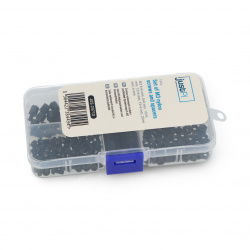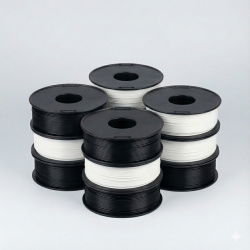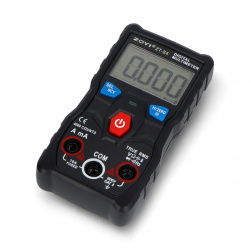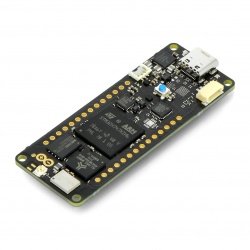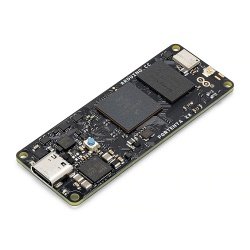The Italian manufacturer Arduino introduced a series of Portenta boards, which have been appreciated by customers because of their full professionalism. Portenta are systems equipped with microcontrollers, which are extremely efficient and energy-saving, with their cores working independently of each other, resulting in the highest functionality. Portenta's systems are dedicated to work with IoT systems (Internet of Things) and will perfectly fulfill their tasks in the field of industry and agriculture. The products have WiFi modules, battery power supply and 80-pin connectors that enable work on more peripherals. The Portenta series is also suitable for handling Artificial Intelligence tasks. Moreover, Arduino Portenta main modules have dimensions compatible with the MKR board family. In the Portenta series there is also Carrier Board, which has the ability to connect aerials, other in and out devices, and the serial interfaces such as RS232/485 and CAN. Portenta series is an advanced circuitry with great versatility and it can be used for various purposes.
Arduino Portenta boards
Arduino Portenta Hat Carrier - Raspberry Pi extension for Arduino Portenta - Arduino ASX00049
Arduino Portenta Hat Carrier is an extension for Arduino Portenta, thanks to which you can turn your Arduino into a single-board computer compatible with shields and cameras...- Reduced price
- SPECIAL OFFERS
Arduino Portenta H7 Lite Connected - ABX00046
The Portenta H7 Lite Connected Arduino board comes with additional wireless chips: WiFi and Bluetooth , as well as a cryptographic chip , which the regular Portenta H7...- Reduced price
- SPECIAL OFFERS
Arduino Portenta H7 - ABX00042
Arduino® Portenta H7 is a new family of chips designed for IoT applications. Thanks to STM32H747 microcontroller equipped with Cortex-M7 and Cortex-M4 cores, this powerful...Arduino Portenta C33 - ABX00074
The Arduino Portenta C33 offers high performance thanks to the Renesas ARM Cortex M33 microcontroller. Supporting WiFi and Bluetooth Low Energy connectivity, it stands out...Arduino Portenta X8 - ABX00049
Arduino Portenta X8 is a very efficient industrial module with a pre-installed Linux operating system. It is equipped with WiFi wireless connectivity and Bluetooth Low...Arduino Pro 4G - EMEA - LTE Cat.4 mini PCIe module for Arduino Portenta - TPX00201
Arduino Pro 4G is an advanced mini PCIe module that allows you to add 4G connectivity to projects based on the Portenta platform , ensuring fast data transfer and wide...Arduino Portenta Breakout - ASX00031
The board is an extension of Arduino® Portenta module with additional connectors and leads. The Portenta Breakout module features a power switch, a DIP switch for selecting...Arduino Portenta H7 Lite - ABX00045
The Arduino Portenta Lite was created for those who want the performance of the standard Portenta, but without the video output and advanced encryption chip . Portenta Lite is...Arduino Portenta Cat. M1/NB IoT GNSS Shield - ASX00027
Overlay designed for Arduino Portenta module, enables LPWAN communication in Cat. M1 / NB IoT and GNSS positioning. The module is based on the Cinterion TX62 chip,...Arduino Portenta Max Carrier - ABX00043
The Arduino Pro Portenta Max Carrier board allows you to turn a Porten module into a single board computer or a structure that enables the use of artificial intelligence in...Arduino Portenta Mid Carrier - ASX00055
Portenta Mid Carrier is an advanced prototyping tool that works with Portenta C33, Portenta H7 and Portenta X8 . It enables quick access to high density signals via dedicated...Arduino Pro 4G - GNSS Global - LTE Cat.4 mini PCIe module for Arduino Portenta - TPX00200
Arduino Pro 4G Module GNSS Global is an advanced module expanding LTE Cat.4 connectivity for Portenta series devices. It offers global compatibility with 4G networks and...Arduino Portenta Proto Kit ME - Motion Environment - Prototype kit - AKX00073
Arduino Portenta Proto Kit ME is an advanced prototyping kit for IoT, automation, environmental and traffic monitoring projects. It includes Portenta H7 - a powerful...Arduino Portenta Proto Kit VE - Vision Environment - Prototype kit - AKX00074
Arduino Portenta Proto Kit VE is a comprehensive solution for professionals involved in prototyping vision and environmental monitoring systems . The kit combines advanced...WisGate Edge Lite 2 Europe - indoor LoRaWAN - Ethernet, WiFi, LTE gateway - Arduino TPX00098
WisGate Edge Lite 2 is an Arduino Pro series product, based on RakWireless , which provides secure and reliable wireless connectivity for a wide range of professional...WisGate Edge Pro Europe - outdoor LoRaWAN - Ethernet, WiFi, LTE gateway - Arduino TPX00095
The WisGate Edge Pro external LoRaWAN gateway is an Arduino Pro product based on RakWireless. It provides secure and reliable wireless connectivity for a wide range of...See also
Arduino Portenta H7 – new board manufactured by Arduino
Arduino Portenta H7 is a professional board designed for high demanding industrial applications, especially in the IoT industry. The board is small-sized, but extremely efficient and energy-saving above all. Portenta board is equipped with STM32H747 microcontroller with Cortex-M7 core (up to 480 MHz) and Cortex-M4 core (up to 240 MHz). The construction of the Portenta board ensures that two independent tasks are able to be performed at the same time.
Moreover, Arduino Portenta H7 supports programs written in Arduino, MicroPython or JavaScript language. The board also includes a cryptographic chip, LiPo charger chip, WiFi and Bluetooth module. Furthermore, it is also possible to communicate via the LoRa, LTE Cat-M and NB-IoT standards. The new Portenta board performs works that require the use of artificial intelligence, cameras, specialized communication interfaces, and even extensive, custom peripherals.
Arduino Portenta - what are its greatest advantages?
Even without extensions, the Arduino Portenta H7 remains very flexible and efficient. The high functionality is a result mainly of the two threads that can work separately due to the Remote Procedure Call mechanism. The shape of the board has been adjusted to the MKR standard, making it compatible with Shields. The board is versatile and compatible. With the dedicated Carrier expansion board, the functionality of the H7 board is further enhanced with 80-pin connectors. USB, RJ-45, CAN bus, audio input and output, camera and DisplayPort output. With Gigabit Ethernet support, it is possible to develop the board into a small Access Point, network drive or UART to Ethernet converter. There is also a SIM card connector available on the module, so you can connect Arduino to NBIoT or GPRS network. The board can also communicate via LoRa technology. Moreover, capabilities of the board can be further extended by means of AI modules connected via miniPCI interface.
Meet the practical use of the Portenta boards!
Arduino Portenta can perform many complicated tasks simultaneously. This means that while one core will be busy performing a simple task, the other will be able to calculate a complex algorithm. The board also allows to run processes created with TensorFlow™ Lite software, which is used for machine learning and neural networking. Using such an advanced architecture allows to support applications, programs and codes such as: Arduino (using Arm® Mbed™ OS), Mbed™, Micropython / Javascript and TensorFlow™. One of the functions of the board is the possibility to use a chip with a built-in graphic accelerator. The STM32H747 microcontroller GPU allows the Portenta H7 board to connect to an external monitor. An additional extension of Portenta Carrier allows you to create an eNUC-class computer. The GPU also features a JPEG encoder and decoder. In addition, the board is equipped with Bluetooth 5.1 LE and WiFi 65 Mbps. Communication via LoRa, LTE Cat-M and NB-IoT standards is also possible. Portenta board is therefore a perfect tool both for the industry engineers and the advanced individual programmers who would like to explore the electronics in their own projects.































































































































































































































































































































